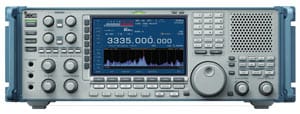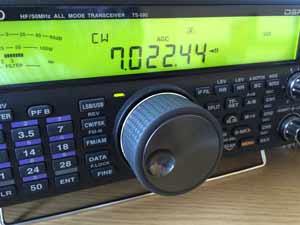Double & Triple Conversion Superheterodyne Radio
Multiple conversion superheterodyne radio receivers including the double or triple conversion sets provide performance advantages over the basic single conversion superhet.
Superhet Radio Tutorial Includes:
Superhet radio
Superhet theory
Image response
Block diagram / overall receiver
Design evolution
Double & multi-conversion superhet
Specifications
See also: Radio types
Although a single conversion superhet radio can work very well, there can be issues, particularly with image rejection.
There is a wide range of performance levels required. Lower performance is needed for applications like domestic broadcast receivers, but much higher performance is needed for professional receivers for two way radio communications, specialist signal reception for items such as space research, test receivers for EMC/EMI testing and the like.
Also in many radios that were developed before the widespread use of frequency synthesizers, frequency stability was an issue. Both of these problems could be addressed in the RF circuit design by using a double conversion, or sometimes even a triple conversion superhet radio.
Even with the introduction of frequency synthesizers that provide the frequency stability needed, multiple conversion superhet radios are widely used in performance radios like radio communications receivers that require very high levels of image rejection to be achieved.
Video: Understanding multiconversion and double conversion superhet radios
Reason for using double superheterodyne radio receiver
When settling on the radio RF circuit design and choosing the intermediate frequency for a superheterodyne radio receiver there is a trade-off to be made between the advantages of using a low frequency IF or a high frequency one as each has its own advantages and disadvantages.
High frequency IF: For any intermediate frequency within a superhet radio the image response appears at a frequency equal to twice that of the IF away from the wanted one. Making the IF as high as possible enables the image response to be as far away as possible from the wanted signal, making the RF filtering to remove the unwanted response much easier, and much better levels of rejection can be obtained.
Accordingly the use of an intermediate frequency with a high frequency provides good image rejection. Some modern HF band communications receivers that cover frequencies up to 30 MHz, may have first IFs of 50 or 60 MHz to ensure a god level of performance.
Low frequency IF: The advantage of choosing a lower frequency IF is that the filters that provide the adjacent channel rejection are lower in frequency. The use of a low frequency IF enables the performance to be high, while keeping the cost low.
Although filters like ceramic filters, crystal filters and the like have improved immeasurably in recent years, costs and performance are still better at lower frequencies. Certainly if 60 MHz IFs are used for the main selectivity, then the filters at these frequencies would not perform as well, and they would be considerably more expensive.
Accordingly there are two conflicting requirements which cannot be easily satisfied using a single intermediate frequency. The solution is to use a double conversion superheterodyne topology to provide a means of satisfying both requirements. Sometimes even a triple conversion superhet may be used to provide the required performance and flexibility.

Image courtesy Icom UK
Basic double superheterodyne receiver concept
The basic concept behind the double superhet radio receiver is the use of a high intermediate frequency to achieve the high levels of image rejection that are required, and a further low intermediate frequency to provide the levels of performance required for the adjacent channel selectivity.
Typically the receiver will convert the incoming signal down to a relatively high first intermediate frequency, IF stage. This may even be above the incoming frequency. This high frequency first IF stage enables the high levels of image rejection to be achieved.
As the image frequency lies at a frequency twice that of the IF away from the main or wanted signal, the higher the IF, the further away the image is and the easier it is to reject at the front end.

Once the signal has passed through the first IF stages at the higher frequency, it is then passed through a second mixer to convert it down to a lower intermediate frequency where the narrow band filtering is accomplished so that the adjacent channel signals can be removed.
As the lower frequency, filters are cheaper and the performance is normally better, although filter technology has improved significantly allowing higher frequency filters to be used. A 9 MHz filter, for example, would not be considered as a high frequency filter these days.
Double superheterodyne topologies
While the basic concept for the double superheterodyne radio receiver involving two stages of frequency conversion may remain the same, there are a number of different "styles" that can be adopted:
Fixed frequency first oscillator: This RF design format for a double conversion superheterodyne receiver was popular before the days of frequency synthesizers and other very stable local oscillators.
It was widely used in many amateur radio or ham radio receivers where a band of 500 kHz was normally tuned to cover a particular band. This form of receiver was able to provide significant improvements in stability performance as well as improved image rejection, although the wide-band first IF stage was often open to some direct pick-up.
A switched crystal oscillator in the first conversion would provide a stable first local oscillator oscillator was used to provide the local oscillator for the first conversion. A bandpass filter would be used to provide selectivity and allow a band of frequencies to be passed.
The second local oscillator would allow tuning over the range allowed by the bandpass filter. When further coverage was required, the first, crystal controlled oscillator, would need to be switched to the next crystal. In this way continuous coverage could be obtained, albeit with a large number of crystals.
Block diagram of a superhet with crystal controlled first conversion
Typically used in amateur radio HF receivers in the late 1960s to early 1990s.Apart from providing high levels of image rejection, this concept gave considerably improved levels of frequency stability for receivers of the time. However, it did require that a large number of switched bands was needed and for continuous coverage from 1 to 30 MHz with 500kHz each band, the number of crystals and bands was enormous. Nowadays frequency synthesizers mean that this RF circuit design format is rarely needed or used.
Tuned first oscillator: This is the most usual format for the RF design of a double conversion superheterodyne receiver. The first conversion uses a variable frequency oscillator which converts the signal to the first IF.
Double conversion superhet using a frequency synthesizer for the first LO Although little selectivity is generally provided in the first IF, often a filter known as a roofing filter may be used to provide some adjacent channel filtering. This prevents very strong adjacent channel signals from overloading the later stages of the IF. However the main selectivity is still provided in the lower frequency IF stages.
The first local oscillator would typically be some form of frequency synthesizer as these are widely used and relatively cheap and easy to implement. They have excellent stability and can be programmed via a microprocessor enabling facilities like keypad frequency entry, tuning knob (controlled via a processor), scanning and much more.
Note on the Frequency Synthesizers:
RF frequency synthesizers enable stable signals to be produced and controlled by a programmable input. There are several different types of synthesizer: some based on phase locked loop techniques, and others use digital technology to create a waveform directly. Often complete synthesizers may incorporate one or more types of technology
Read more about Frequency Synthesizers.

Even this mid-range ham radio transceiver uses a multiple conversion superhet RF design
There are many ways in which a multiple conversion superhet topology can be implemented. There is no hard and fast pattern for the optimum topology. Some even change the topology within the radio dependent upon the band in use. In this way the best option can be adopted for the frequencies and type of application envisaged.
Triple conversion superheterodyne receiver
For some advanced RF designs, especially those using microwave frequencies, there may be advantages in using three conversions or occasionally more. While these receivers are less common, there are some advanced receivers, often for professional or top end ham radio applications that need this number of conversions to attain the very high levels of performance needed.
Their RF design provides for high levels of close in or adjacent channel selectivity, while still achieving high levels of image rejection. For applications where both specifications are particularly important, this may only be achieved by using a number of conversion processes. In cases like these, triple conversion superheterodyne receivers may be needed, although costs are naturally high in view of the additional circuitry required.
These multiple conversion superhet radios can adopt a variety of different topologies, some up-converting in frequency first and then down converting. Some even adopt different numbers of conversions according to the frequencies being received. There are many different approaches that can be taken.
The double superheterodyne radio receiver is normally found where high levels of performance are required - often for high performance monitoring and two way radio communications. The additional circuitry needed adds cost, and to minimise the occurrence of spurious signals within the receiver, the design must be undertaken with care. However, it is possible to achieve very high levels of performance with a double superheterodyne or where particularly needed a triple superheterodyne radio receiver.
More Essential Radio Topics:
Radio Signals
Modulation types & techniques
Amplitude modulation
Frequency modulation
OFDM
RF mixing
Phase locked loops
Frequency synthesizers
Passive intermodulation
RF attenuators
RF filters
RF circulator
Radio receiver types
Superhet radio
Receiver selectivity
Receiver sensitivity
Receiver strong signal handling
Receiver dynamic range
Return to Radio topics menu . . .





